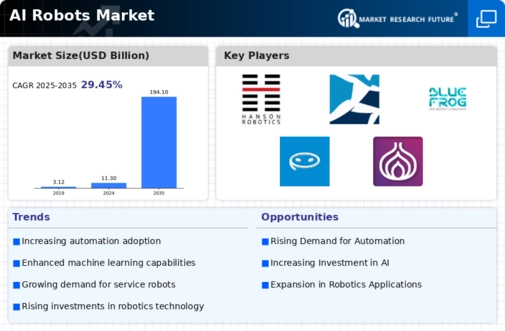Top Industry Leaders in the AI Robots Market

The AI Robot Revolution: Analyzing the Competitive Landscape
The AI Robots market is experiencing an exhilarating ascension, projected to reach a staggering growth by 2028. In this electrifying arena, established players and nimble startups wrestle for dominance, crafting intelligent machines that blur the lines between human and artificial capabilities. Delving into the key contenders, their strategies, and the metrics that dictate success is crucial for navigating this rapidly evolving terrain.
Key Players :
- Nvidia Corporation
- Abb Ltd
- Intel Corporation
- 1X, Google (Alphabet Inc)
- IBM Corporation
- Hanson Robotics
- Boston Dynamics
- Xilinx Inc (AMD)
- Fanuc Corporation
- KUKA AG
- Blue Frog Robotics
- Promobot
- Vicarious FPC, Inc
- Neurala Inc.
- Veo Robotics Inc
- Miso Robotics Inc
Strategies for AI Robot Supremacy:
-
Specialization: Players are focusing on specific applications like healthcare, logistics, or household assistance, tailoring their robots for optimal performance in each domain.
-
AI & Machine Learning (ML) Integration: Robust AI and ML algorithms are the core of intelligent robots, enabling them to learn, adapt, and make decisions autonomously. Investing in advanced AI research and development is crucial.
-
Sensor Fusion & Data Analytics: Equipping robots with a symphony of sensors and processing the data effectively allows for nuanced environment perception and accurate decision-making.
-
Collaboration & Partnerships: Partnering with technology providers, research institutions, and industry leaders fosters innovation, expands access to resources, and facilitates integration into existing infrastructure.
Market Share Analysis & Key Metrics:
-
Robot Unit Sales: The total number of robots sold reflects a player's reach, market penetration, and overall revenue generation potential.
-
Average Selling Price (ASP): Measuring the average price at which robots are sold indicates a brand's premium positioning and value proposition.
-
Deployment Rates & Service Revenue: The number of robots deployed and ongoing service contracts, like maintenance and software updates, contribute to recurring revenue streams.
-
Technology Innovation & Patent Filings: The pace of technology development, measured by patent filings and innovative features, reflects a player's commitment to pushing the boundaries of AI robotics.
New Frontiers & Emerging Trends:
-
Human-Robot Collaboration (HRC): Robots are increasingly working alongside humans in shared workspaces, necessitating intuitive interfaces, safety protocols, and seamless communication.
-
Edge Computing & Decentralized Intelligence: Processing data at the edge of the network, closer to the robots, reduces latency and enables faster, more autonomous decision-making.
-
Explainable AI (XAI): As AI complexity increases, ensuring transparency and understandability of robot decisions becomes crucial for trust and ethical considerations.
-
Sustainability & Green Robotics: Developing energy-efficient robots and utilizing them for tasks like environmental monitoring and disaster response adds a green dimension to the market.
Investment Trends & The Road Ahead:
-
AI & ML Infrastructure & Talent Acquisition: Investing in advanced AI platforms, supercomputing capabilities, and attracting top AI talent is critical for maintaining a competitive edge.
-
Robotics Hardware & Sensor Development: Continued investment in advanced materials, miniaturization technologies, and high-precision sensors empowers robots with greater dexterity and environmental awareness.
-
Cybersecurity & Data Privacy: Robust cybersecurity measures and transparent data handling practices are paramount for building trust and ensuring responsible AI robot development.
-
Focus on Ethical Considerations: Integrating ethical frameworks into AI algorithms and addressing societal concerns surrounding job displacement and robot safety are crucial for responsible market growth.
The AI Robots market is a thrilling arena witnessing rapid evolution and fierce competition. Understanding the key players, their strategies, and the factors shaping market share will equip you to navigate this dynamic landscape. By prioritizing AI innovation, ethical development, and strategic partnerships, the future belongs to those who can harness the power of AI robots to reshape industries and enrich human lives.
This comprehensive overview should provide you with a solid foundation for understanding the competitive landscape of the AI Robots market. Remember, staying informed about the latest trends and adapting your strategies will be key to thriving in this ever-evolving revolution.
Latest Company Updates:
-
Boston Dynamics' Stretch robot: This agile robot can handle boxes and navigate cluttered environments, making it ideal for warehouse and logistics operations. -
Amazon's Astro robot: This home robot can navigate your home, play music, and even make video calls, offering a glimpse into the future of domestic AI assistants. -
Hyundai's DAL-e 2 humanoid robot: This advanced robot can walk, run, and even perform parkour tricks, showcasing the potential of humanoid robots in various applications.

